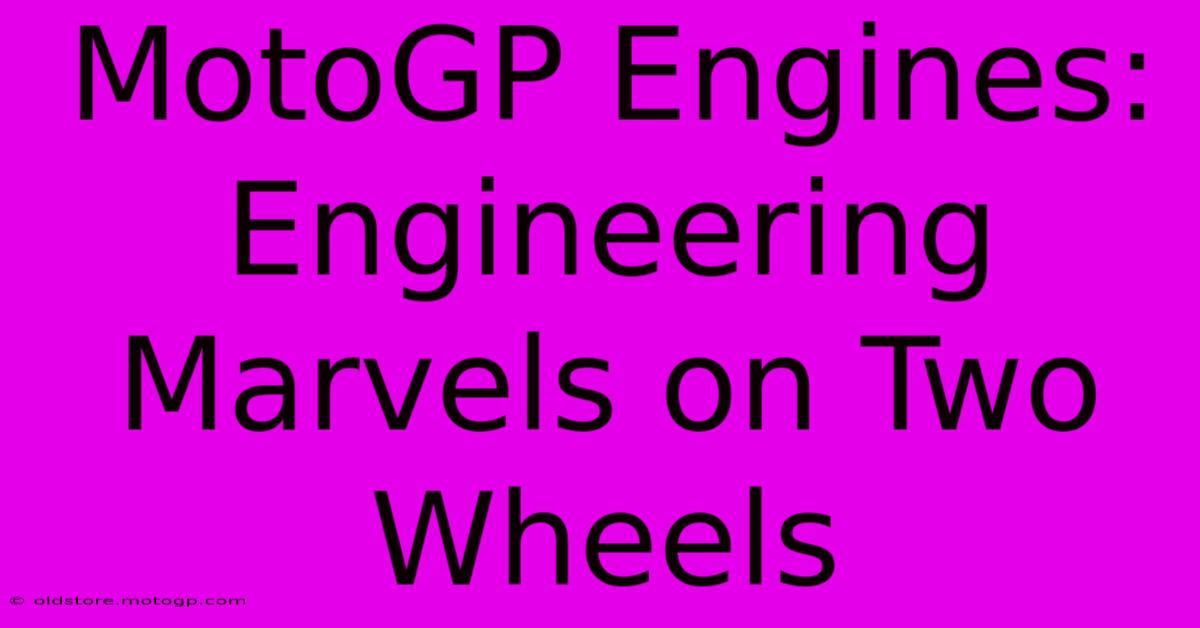MotoGP Engines: Engineering Marvels On Two Wheels

Table of Contents
MotoGP Engines: Engineering Marvels on Two Wheels
MotoGP. The name conjures images of screaming engines, breathtaking speeds, and nail-biting races. But behind the spectacle lies a fascinating world of cutting-edge engineering, particularly in the heart of each machine: the engine. These aren't your average motorcycle engines; they're highly specialized powerhouses pushing the boundaries of performance and technology. This article delves into the marvel of MotoGP engines, exploring their design, technology, and the relentless pursuit of speed and efficiency.
The Heart of the Beast: Engine Configurations
For years, MotoGP engines have been predominantly prototypical 1000cc four-stroke engines, though regulations change frequently. These aren't simply modified street bike engines; they're meticulously crafted pieces of machinery designed for maximum power output within the confines of the sport's rules. Key features include:
-
Inline four-cylinder configuration: This layout offers a good balance of power, compactness, and manageable vibrations. The configuration allows for efficient packaging within the chassis.
-
High Revving Capabilities: These engines operate at incredibly high RPMs, often exceeding 18,000 rpm, extracting maximum power from every drop of fuel. This necessitates incredibly robust internal components.
-
Sophisticated Valve Train: Advanced technologies like pneumatically-actuated valves (or even more complex systems) allow for precise valve timing and incredibly high lift, optimizing airflow for peak power delivery throughout the rev range.
-
Lightweight Materials: Everything from the engine casing to the internal components is meticulously designed for minimal weight, maximizing power-to-weight ratio and improving handling. Materials such as titanium, magnesium, and carbon fiber are commonplace.
-
Complex Fuel Injection Systems: Precise fuel delivery is critical for maximizing power and efficiency. MotoGP engines utilize advanced electronic fuel injection systems that constantly adjust fuel delivery based on various factors like engine speed, throttle position, and air temperature.
Beyond the Basics: Technological Advancements
MotoGP engines are a testament to continuous innovation. Engineers are constantly pushing the limits, exploring new technologies to gain even the smallest competitive edge. Here are some cutting-edge advancements:
Seamless Shift Gearboxes:
These systems allow for incredibly quick and smooth gear changes without the need to close the throttle, maintaining acceleration and speed. This technology reduces the time spent shifting gears, contributing to faster lap times.
Ride-by-Wire Throttle Control:
This technology eliminates the mechanical link between the throttle and the engine. It allows for more precise throttle control, enhancing the rider's ability to manage power delivery, particularly during corner entry and exit.
Traction Control:
Sophisticated traction control systems constantly monitor wheel speed and adjust engine power to prevent wheel spin, particularly crucial during acceleration out of corners. This allows riders to push the limits of grip without losing control.
Engine Braking Control:
This helps manage engine braking during deceleration, improving stability and control, especially under braking in corners. This is a crucial safety feature at high speeds.
The Future of MotoGP Engines
The quest for performance never ends. While the current regulations favor four-stroke engines, future iterations may see new innovations, such as different cylinder configurations or further advancements in hybrid technology. The continuous evolution of MotoGP engines ensures that the sport remains at the forefront of motorcycle technology, pushing the boundaries of engineering excellence on two wheels. The future of MotoGP engines is bright, promising even more powerful, efficient, and technologically advanced machines.
Conclusion
MotoGP engines are not just engines; they're intricate masterpieces of engineering, embodying the relentless pursuit of speed, efficiency, and technological advancement. Each component is carefully considered, designed, and manufactured to achieve maximum performance within the confines of the sport's rules. The continuous innovation and development in these engines are truly awe-inspiring, ensuring that MotoGP continues to be a spectacle of speed and engineering excellence. The passion and dedication involved in creating these marvels of engineering make them far more than just engines – they are symbols of innovation and competitive spirit.

Thank you for visiting our website wich cover about MotoGP Engines: Engineering Marvels On Two Wheels. We hope the information provided has been useful to you. Feel free to contact us if you have any questions or need further assistance. See you next time and dont miss to bookmark.
Featured Posts
-
Watch Moto Gp The Ultimate Escape
Feb 22, 2025
-
Moto 3 Motorcycle The Legacy Of Moto 3 Racing
Feb 22, 2025
-
Moto Gp Qualifying From Zero To Hero
Feb 22, 2025
-
The Invisible Force Understanding Moto Gp Aero
Feb 22, 2025
-
Dont Miss Out What Time Is The Sprint Race
Feb 22, 2025
